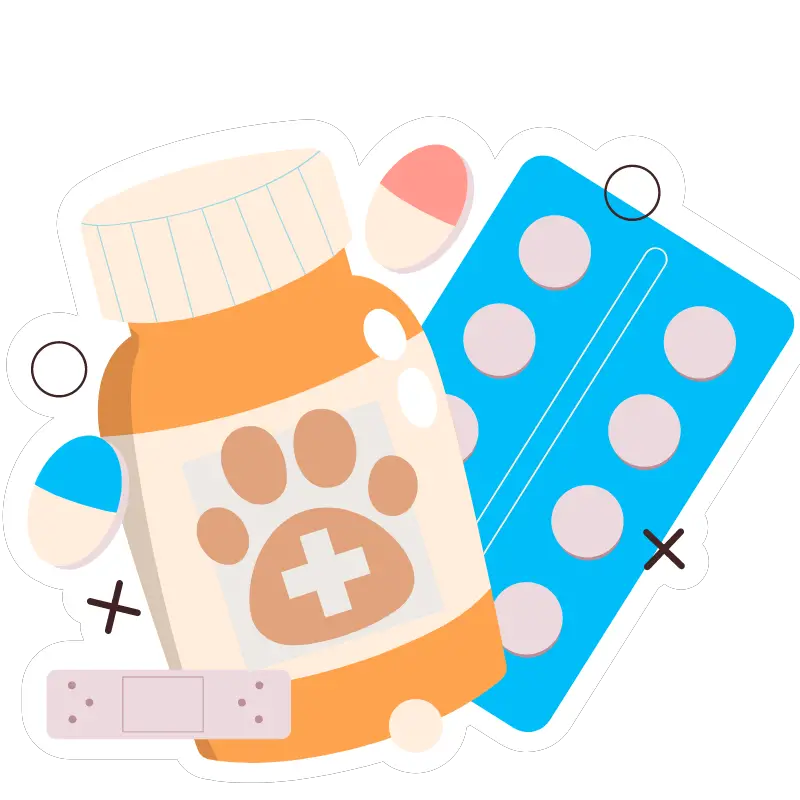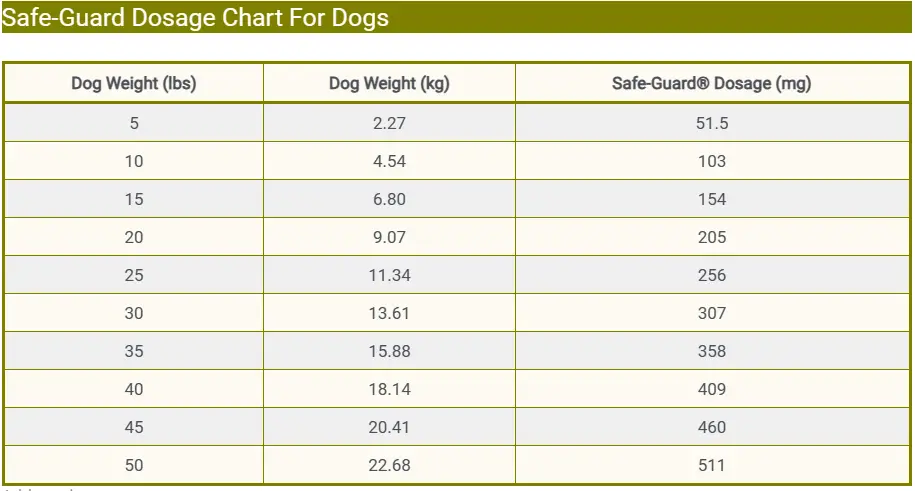The safe dosage of Safe-Guard® for treating Taenia Tapeworms, Hookworms, Roundworms, and Whipworms is 50 mg per kilogram of body weight (which is approximately 22.7 mg per pound). This dosage should be repeated for three consecutive days.
Safe-Guard® Dosage For Dogs

-
Ideal Dose: 50 mg/kg (22 mg/lb)
-
Uses: Taenia Tapeworms, Hookworms, Roundworms, and Whipworms.
-
Active Ingredients: Fenbendazole
-
FDA Approved: Yes
-
Variants: Paste, Granules, or Suspension
-
Storage & Handling: Room Temperature
-
Administration: 3 consecutive days
Disclaimer: Self-medication can be hazardous. Please consult your veterinarian for personalized guidance on the appropriate dosage for your furry friend’s specific condition.
Safe-Guard® is a brand of dewormer medication commonly used for dogs to treat and control various internal parasites such as roundworms, hookworms, whipworms, and tapeworms.
The dosage of Safe Guard for dogs depends on the weight of the dog and the form of the medication being used (paste, granules, or suspension).
However, it is essential to determine the correct safeguard dosage for dogs to ensure their safety and comfort.
In this guide, we’ll delve into the intricacies of administering safeguard to dogs, exploring the appropriate dosage and considerations for pet owners to keep their canine companions happy and healthy during travels.
Safe-Guard® Dosage For Dogs
Mix the daily dose of Safe-Guard® canine dewormer at a rate of 50 mg per kilogram (approximately 22 mg per pound) with a small amount of regular dog food. Ensure that your pup consumes all the medicated food. You may need to moisten dry dog food to aid in mixing.
To completely treat tapeworms in canines, repeat the Safe-Guard® dose for three consecutive days.
Safe-Guard® dewormer is safe for use in puppies aged 6 weeks or older and adult dogs, including pregnant bitches.
Do not deworm a dog or puppy younger than 6 weeks or that is unwell. Consult your veterinarian for a diagnosis of the illness.
Safe-Guard Dosage Chart For Dogs
| Dog Weight (lbs) | Dog Weight (kg) | Safe-Guard® Dosage (mg) |
|---|---|---|
| 5 | 2.27 | 51.5 |
| 10 | 4.54 | 103 |
| 15 | 6.80 | 154 |
| 20 | 9.07 | 205 |
| 25 | 11.34 | 256 |
| 30 | 13.61 | 307 |
| 35 | 15.88 | 358 |
| 40 | 18.14 | 409 |
| 45 | 20.41 | 460 |
| 50 | 22.68 | 511 |
Related Post: Dramamine Dosage For Dogs
Uses
Safe-Guard® is a widely used dog dewormer, offering effective treatment and control against various internal parasites. Here are the primary uses of Safe-Guard® for dogs:
-
Treatment of Intestinal Worms: Safe-Guard® is effective against a range of intestinal worms commonly found in dogs, including roundworms (Toxocara canis, Toxascaris leonina), hookworms (Ancylostoma caninum, Uncinaria stenocephala), whipworms (Trichuris vulpis), and certain species of tapeworms (such as Taenia species).
-
Prevention of Reinfestation: Safe Guard canine dewormer not only treats existing worm infestations but helps prevent reinfestation when used as directed. Regular deworming is essential for maintaining your dog’s overall health and preventing the spread of parasites.
-
Safe for Puppies and Adult Dogs: Safe-Guard® is safe for use in puppies as young as 6 weeks old and adult dogs. This makes it suitable for deworming dogs of all ages, including pregnant bitches.
-
Convenient Administration: Safeguard for dogs is available in various formulations, including chewable tablets, granules, and suspension, making it convenient for dog owners to administer to their pets. It can be given with food to ensure easy consumption.
-
Treatment Regimen: The treatment regimen typically involves administering Safe-Guard® once daily for multiple days, as directed by your veterinarian. For example, the dosage for treating certain tapeworm species may require administration for three consecutive days.
Related Post: SAMe Dosage For Dogs
Potential Side Effects
-
Gastrointestinal Upset: Potential for vomiting, diarrhea, or loss of appetite.
-
Allergic Reactions: Rare possibility of itching, hives, facial swelling, or difficulty breathing.
-
Neurological Symptoms: Uncommon occurrence of disorientation, tremors, or seizures.
-
Overdose: Possibility if administered at excessively high doses, leading to lethargy or weakness.
-
Drug Interactions: Safeguard dog dewormer may interact with other medications or conditions and require careful monitoring.
Which Dogs Should Not Take Safeguard
Canines with the following health issues should not take safeguard without veterinary recommendations.
-
Safe-Guard® is not recommended for use in puppies younger than 6 weeks of age.
-
Dogs currently ill or with underlying health conditions may not be suitable candidates for Safe-Guard®. It’s essential to address the underlying illness before considering deworming.
-
Dogs with known allergies to the active ingredients in Safe-Guard® should not be given the medication.
-
Safe-Guard® may interact with certain medications, so dogs taking other medications should only use Safe-Guard® under veterinary supervision.
-
While Safe-Guard® is generally considered safe for use in pregnant or nursing dogs, it’s essential to consult with a veterinarian before administering the medication to ensure the mother’s and her puppies’ safety.










![Can Dogs Eat Blood? 7 Side Effects [Expert Opinion]](https://petskor.com/wp-content/uploads/2022/04/Webp.net-resizeimage-12.jpg)
